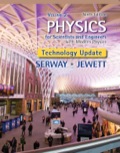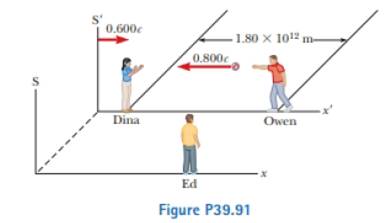
Concept explainers
Owen and Dina are at rest in frame S.’ which is moving at 0.600c with respect to frame S. They play a game of catch while Ed. at rest in frame S, watches the action (Fig. P39.91). Owen throws the ball to Dina at 0.800c (according to Owen), and their separation (measured in S') is equal to 1.80 × 1012 m. (a) According to Dina, how fast is the ball moving? (b) According to Dina, what time interval is required for the ball to reach her? According to Ed, (c) how far apart are Owen and Dina, (d) how fast is the ball moving, and (e) what time interval is required for the ball to reach Dina?

(a)
The speed of ball according to Dina.
Answer to Problem 39.91CP
The speed of ball according to Dina is
Explanation of Solution
Given info: The frame
If both persons are in same frame then the velocity of ball will be same for both persons.
Owen and Dina are in same frame
Conclusion:
Therefore, the speed of ball according to Dina is
(b)
The time interval is required for the ball to reach Dina.
Answer to Problem 39.91CP
The time interval is required for the ball to reach Dina is
Explanation of Solution
Given info: The frame
Write the expression for time taken by the ball to reach Dina.
Here,
Substitute
The speed of the light is,
Substitute
Conclusion:
Therefore, the time interval is required for the ball to reach Dina is
(c)
The distance between Owen and Dina with respect to Ed.
Answer to Problem 39.91CP
The distance between Owen and Dina with respect to Ed is
Explanation of Solution
Given info: The frame
Write the expression of distance between Owen and Dina with respect to the other frame
Here,
Substitute
Conclusion:
Therefore, the distance between Owen and Dina with respect to Ed is
(d)
The speed of the ball with respect to Ed.
Answer to Problem 39.91CP
The speed of the ball with respect to Ed is
Explanation of Solution
Given info: The frame
Write the expression of speed of the ball with respect to the other frame
Here,
Substitute
Conclusion:
Therefore, the speed of the ball with respect to Ed is
(e)
The time interval required for the ball to reach Dina with respect to Ed.
Answer to Problem 39.91CP
The time interval required for the ball to reach Dina with respect to Ed.
is
Explanation of Solution
Given info: The frame
Write the expression for time taken by the ball to reach Dina with respect to Ed.
Here,
Write the expression for the Lorentz factor.
Substitute
Substitute
Conclusion:
Therefore, the time interval required for the ball to reach Dina with respect to Ed.
is
Want to see more full solutions like this?
Chapter 39 Solutions
EBK PHYSICS FOR SCIENTISTS AND ENGINEER
- Please solve and answer this problem correctly please. Thank you!!arrow_forwarda) Use the node-voltage method to find v1, v2, and v3 in the circuit in Fig. P4.14. b) How much power does the 40 V voltage source deliver to the circuit? Figure P4.14 302 202 w w + + + 40 V V1 80 Ω 02 ΣΑΩ 28 A V3 + w w 102 202arrow_forwardPlease solve and answer this problem correctly please. Thank you!!arrow_forward
- You're on an interplanetary mission, in an orbit around the Sun. Suppose you make a maneuver that brings your perihelion in closer to the Sun but leaves your aphelion unchanged. Then you must have Question 2 options: sped up at perihelion sped up at aphelion slowed down at perihelion slowed down at aphelionarrow_forwardThe force of the quadriceps (Fq) and force of the patellar tendon (Fp) is identical (i.e., 1000 N each). In the figure below angle in blue is Θ and the in green is half Θ (i.e., Θ/2). A) Calculate the patellar reaction force (i.e., R resultant vector is the sum of the horizontal component of the quadriceps and patellar tendon force) at the following joint angles: you need to provide a diagram showing the vector and its components for each part. a1) Θ = 160 degrees, a2) Θ = 90 degrees. NOTE: USE ONLY TRIGNOMETRIC FUNCTIONS (SIN/TAN/COS, NO LAW OF COSINES, NO COMPLICATED ALGEBRAIC EQUATIONS OR ANYTHING ELSE, ETC. Question A has 2 parts!arrow_forwardThe force of the quadriceps (Fq) and force of the patellar tendon (Fp) is identical (i.e., 1000 N each). In the figure below angle in blue is Θ and the in green is half Θ (i.e., Θ/2). A) Calculate the patellar reaction force (i.e., R resultant vector is the sum of the horizontal component of the quadriceps and patellar tendon force) at the following joint angles: you need to provide a diagram showing the vector and its components for each part. a1) Θ = 160 degrees, a2) Θ = 90 degrees. NOTE: USE DO NOT USE LAW OF COSINES, NO COMPLICATED ALGEBRAIC EQUATIONS OR ANYTHING ELSE, ETC. Question A has 2 parts!arrow_forward
- No chatgpt pls will upvotearrow_forwardThe force of the quadriceps (Fq) and force of the patellar tendon (Fp) is identical (i.e., 1000 N each). In the figure below angle in blue is Θ and the in green is half Θ (i.e., Θ/2). A) Calculate the patellar reaction force (i.e., R resultant vector is the sum of the horizontal component of the quadriceps and patellar tendon force) at the following joint angles: you need to provide a diagram showing the vector and its components for each part. a1) Θ = 160 degrees, a2) Θ = 90 degrees. NOTE: USE ONLY TRIGNOMETRIC FUNCTIONS (SIN/TAN/COS, NO LAW OF COSINES, NO COMPLICATED ALGEBRAIC EQUATIONS OR ANYTHING ELSE, ETC. Question A has 2 parts!arrow_forwardNo chatgpt pls will upvotearrow_forward
- No chatgpt pls will upvotearrow_forwardSolve and answer the question correctly please. Thank you!!arrow_forward་ The position of a particle is described by r = (300e 0.5t) mm and 0 = (0.3t²) rad, where t is in seconds. Part A Determine the magnitude of the particle's velocity at the instant t = 1.5 s. Express your answer to three significant figures and include the appropriate units. v = Value Submit Request Answer Part B ? Units Determine the magnitude of the particle's acceleration at the instant t = 1.5 s. Express your answer to three significant figures and include the appropriate units. a = Value A ? Unitsarrow_forward
 Principles of Physics: A Calculus-Based TextPhysicsISBN:9781133104261Author:Raymond A. Serway, John W. JewettPublisher:Cengage Learning
Principles of Physics: A Calculus-Based TextPhysicsISBN:9781133104261Author:Raymond A. Serway, John W. JewettPublisher:Cengage Learning Physics for Scientists and Engineers, Technology ...PhysicsISBN:9781305116399Author:Raymond A. Serway, John W. JewettPublisher:Cengage Learning
Physics for Scientists and Engineers, Technology ...PhysicsISBN:9781305116399Author:Raymond A. Serway, John W. JewettPublisher:Cengage Learning Modern PhysicsPhysicsISBN:9781111794378Author:Raymond A. Serway, Clement J. Moses, Curt A. MoyerPublisher:Cengage Learning
Modern PhysicsPhysicsISBN:9781111794378Author:Raymond A. Serway, Clement J. Moses, Curt A. MoyerPublisher:Cengage Learning Physics for Scientists and Engineers: Foundations...PhysicsISBN:9781133939146Author:Katz, Debora M.Publisher:Cengage Learning
Physics for Scientists and Engineers: Foundations...PhysicsISBN:9781133939146Author:Katz, Debora M.Publisher:Cengage Learning College PhysicsPhysicsISBN:9781305952300Author:Raymond A. Serway, Chris VuillePublisher:Cengage Learning
College PhysicsPhysicsISBN:9781305952300Author:Raymond A. Serway, Chris VuillePublisher:Cengage Learning College PhysicsPhysicsISBN:9781285737027Author:Raymond A. Serway, Chris VuillePublisher:Cengage Learning
College PhysicsPhysicsISBN:9781285737027Author:Raymond A. Serway, Chris VuillePublisher:Cengage Learning





